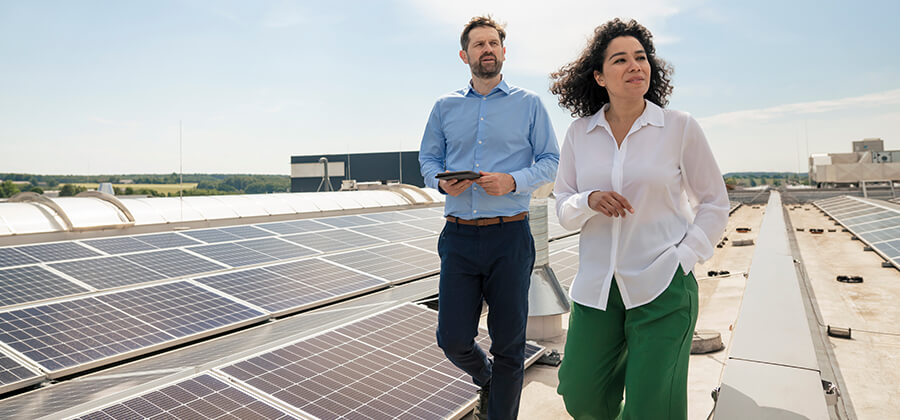Many entrepreneurs would like to, but are hesitant. That is not surprising, for green investments are relatively new and quite complex. Tailor-made work is the key.

As an entrepreneur, you have very little control over rising energy prices. However, this weighs heavily on your budget. By investing in sustainable energy, you kill two birds with one stone: costs savings and good risk management.
In times of crisis it is important to reduce costs, and this also applies to energy. Many entrepreneurs wrongly assume that energy savings can only be achieved by investing in expensive technologies and materials. This need not necessarily be the case. It is often a question of making the right choices in the design and implementation of energy projects.
Companies would also do well to focus on their energy supply. Belgium is highly energy-dependent, and we import more electricity than we export. This energy dependency, coupled with continual price rises, weakens our economy and threatens competitiveness. Companies that invest in renewable energy (wind turbines, solar panels, etc.) or the energy performance of their buildings (for example, by installing an efficient heating system) are less reliant on fluctuating energy prices.
The green image is a bonus. By investing in renewable energy, companies underline their social commitment.
Strange but true: despite all the advantages of investing in renewable energy, many entrepreneurs have cold feet. There are several reasons for this. To begin with, many technologies are quite complex and specialised. Furthermore, it is not always easy to quantify the potential profitability.
Multidisciplinary approach
How do you go about investing in renewables? Sustainable investment is a multidisciplinary project, involving multiple actors. Project developers, investors, design consultancies, construction firms and financing institutions would do well to join forces so as to eliminate as many questions as possible.
Another tip: make an appointment with the bank as soon as possible. The specialists at BNP Paribas Fortis Sustainable Energy Services would be happy to advise you, free of charge. As well as analysing the feasibility of the project, these experts also assess the technical and financial risks. Entrepreneurs also receive guidance on applying for government aid and how to negotiate the legal and regulatory aspects of investment. Sustainable Energy Services closely follows the investment case. The specialists compare the different financing schemes, such as a traditional bank loan, leasing or an energy performance contract. The result? Custom-made financing.
Assisting and advising...
Over the past few years, Sustainable Energy Services have carried out a number of successful projects.
- In Roeselare, Karel Sterckx NV reduced its energy bill by as much as 30% following the construction of two wind turbines
The company produces mushroom substrates, which are needed to grow mushrooms. The climate system needed for this uses a lot of energy, 15,000 MWh of electricity per year to be exact. This is about the same as the energy consumption of 4,000 households. Wind turbines were an obvious choice, but the entrepreneurs realised that the investment would be complex. Our experts took care of the building permit, the profitability study and financing. The result is impressive: today the two wind turbines jointly produce 5,300 MWh per year, accounting for energy savings of 30% and a CO2 emissions reduction of 4,000 tonnes.
- ISSOL, in Liege, develops photovoltaic projects
The company relies on BNP Paribas Fortis for the financial structuring of its projects. ISSOL not only builds solar panels for homes and businesses, the company also provides turnkey services. This is how it works: a company or local authority places a contract with ISSOL to convert a building into an 'electricity plant' by installing solar panels. ISSOL finances that work and is responsible for managing the power plant. In exchange, ISSOL receives income from electricity production. Our specialists helped design this financial structure.
- Lighting expert VSE to build a passive branch in Neder-Over-Heembeek
The company sought an innovative financing solution for the construction of their passive building. BNP Paribas Fortis proposed real estate leasing for a total of 6.6 million euros: 5.7 million euros for the construction of the building and 900,000 euros for the acquisition of building and planting rights on the land, allowing the customer to partly refinance the purchase price of the land. After completion by BNP Paribas Leasing Solutions, the building will be made available by means of a financial lease with a term of 15 years. VSE will then pay rental instalments to repay the loan.
23.05.2016
Fluctuating energy prices? Minimise your risks!
How can a company protect itself against fluctuating energy prices? You have to be a specialist to answer that question, as the energy market is very complex. This is why many companies engage an independent energy adviser, such as GDF Suez Trading.
Sales trader Stéphane Pirotte of GDF Suez Trading explains how companies can protect themselves against fluctuations in the energy markets.
"In essence, there are two options. Do you expect price increases? Buy today. Do you expect price cuts? Defer buying. In a number of interviews we identify the energy needs of the customer, the purchase volume, the degree of coverage, as well as the company's risk profile and objectives. Some companies prefer strict budgetary control, while others opt for a dynamic approach. Our advice is independent: we do not propose which supplier you should do business with. This guarantees an optimal solution for our customers."
Which factors determine energy prices and what are the expectations for the coming months?
According to GDF Suez Trading, there are five key variables:
- The macroeconomic situation
Energy markets follow the economic cycle. For every percentage point the economy grows, the worldwide demand for energy grows by about 0.6%. The economy in emerging countries also plays an important role. Take India, for example. India is a major consumer of fossil fuels, such as coal. Growth or decline of the Indian economy will therefore have an impact on the price of coal. And finally, the exchange rate also affects energy prices. Oil and coal, for example, are listed in US dollars. In other words, a strong euro increases the purchasing power of European industry in the energy market.
- Oil: prices on the rise again
The current oil market is on the rise again, after the price for a barrel of Brent crude dropped in a few months from 110 to 50 dollars. Many companies hedged themselves for the long term by buying oil at a very low price. Today we see a rising demand, particularly in emerging countries and Europe, where the measures taken by the ECB gradually seem to be bearing fruit.
- Coal: the decline continues
Coal prices have plummeted in recent years. The increasing exploitation of shale gas in the US plays an important role in this dynamic. Colombia, until recently one of the major coal suppliers of the US, has been forced to look to other markets. Today, the South American country supplies more coal than ever to Europe. Another effect is also at play: the decrease in emissions in Europe makes electricity generation from coal cheaper (see below). Belgium benefits the least from low coal prices because our country only has one operational coal plant.
- Natural gas: lower production in Europe creates more volatility
Europe relies mainly on imports for its natural gas. Only 30% of our natural gas demand is met by EU countries such as Denmark, the Netherlands and the UK. Every year, natural gas production in the EU decreases. In the Netherlands, for example, gas production will decrease by more than 19 billion cubic metres in just two years. By way of comparison, Belgium consumes 15 billion cubic metres a year... In the short term, the declining European production will be offset by increased imports from Russia.
Our country also imports LNG, natural gas that is liquid at a temperature of -160°C so that it can be transported by ship. The large reserves in Loenhout means that our country is relatively immune to major fluctuations in demand. In the long term, however, it will be important to look for new partnerships, including with Azerbaijan and Turkmenistan. Such agreements could ensure European natural gas supply.
- Emission rights: reform is necessary
The polluter pays – that is the basic principle of emissions trading. Europe introduced this mechanism to reduce GHG emissions, among others. The system is quite complicated. The bottom line is that polluting companies would have to pay increasingly higher emission rights. But the mechanism failed to take into account the impact of the financial and economic crisis.
As a result, emission rights became cheaper, which means companies today are barely 'punished' for their harmful emissions.
23.05.2016
An analysis of the Belgian energy market
Liberalisation, the emergence of renewable energy, the announced phasing out of nuclear energy: the Belgian energy market has been evolving constantly in recent years.

All these developments have an effect on production, prices and supply. Let's take a closer look at the energy landscape. There are at least six players on the Belgian electricity market:
- Electricity producers
They are at the beginning of the chain. The producers generate electricity in nuclear power plants, STEG plants (steam and gas turbine), windmill or solar parks and hydropower plants. All that electricity is fed to the transmission network (high voltage) or the distribution networks (low or medium voltage).
- Energy exchanges
This is where market players buy or sell their energy. The system promotes competition and transparent pricing.
- Transmission system operators
These are responsible for managing the transmission networks at high and very high voltages. Belgium has one transmission system operator, Elia. Belgium is not an island, of course. The transmission networks of all European countries are connected, so countries can import or export electricity, depending on their needs.
- Distribution network operators
These are responsible for managing the distribution networks at low and medium voltages. The distribution network operators supply electricity to the customer and are responsible for street lighting.
- The regulators
The regulators monitor the energy market. They promote users' interests and are in charge of monitoring competition and transparency, among other things. In addition to three regional regulators, Belgium has one federal regulator, the CREG (Commission for the Regulation of Electricity and Gas).
- Customers
Some industrial customers are directly connected to the high-voltage grid. Individual customers and SMEs are supplied through the distribution network.
How is the energy price determined?
The price is determined in part by the energy playing field. This makes sense, as all players have to be compensated for the role they play. The price consists largely of three components, each of which is found in principle on the invoice the customer receives. Let's look at the three different price elements in more detail:
- 'Clean' energy price
The supplier/producer determines the energy price. This price usually consists of a (fixed) subscription price and a variable fee for actual consumption. This fee takes into account the actual cost price as well as costs such as those incurred for green energy and cogeneration certificates, for example.
The Flemish government has made it mandatory for suppliers to supply a certain percentage of electricity from green energy or from cogeneration plants. The suppliers have to provide proof by way of green energy certificates and cogeneration certificates. Suppliers must pay a fine in case of a lack of certificates.
In the Walloon Region, it is the Commission wallonne pour l'Energie (CWAPE) that grants green energy certificates. The number of certificates depends on two parameters: reduction of CO2 emissions and energy output. All energy suppliers must attain a number of green energy certificates relative to their sales volume.
In the Brussels Region, Brugel (the Brussels energy regulator) grants green energy certificates to producers that have reduced CO2 emissions by a certain degree within a fixed period of time. These certificates remain valid for a period of ten years.
- Distribution and transport costs
The distribution and transport network operators charge a fee for the distribution and transport of electricity and natural gas and for the public services they provide (such as public lighting, social tariffs, etc.). The distribution network operators cannot simply customise their tariffs, as they require the government's approval. The distribution and transport costs vary by region.
- Taxes and levies
Different public authorities charge taxes and levies on energy consumption. Some companies have an energy contract with the government and are exempt from a number of charges. One of those charges is the federal energy contribution. This is used to finance the CREG's activities, for example.
Useful information
More information on the Belgian electricity market is available at www.creg.be.
Like to know more about producing green energy?
- in Flanders: www.cogenvlaanderen.be
- in Brussels: www.brugel.be
- in Wallonia: www.cwape.be
03.11.2017
European climate plan: from 20-20-20 to 40-27-27
Reduced greenhouse gas emissions, more renewable energy and better energy efficiency – this is the goal of the European action plan against climate change.
The European Union's climate plan is aimed at slowing down global warming. The intention is for the average global temperature not to rise more than two degrees above that of the pre-industrial era. Europe wants to address greenhouse gas emissions (GHG) in particular, since they are the main culprits of global warming.
The EU's climate plan translates into three main objectives, with a target date of 2020:
- reducing GHG emissions by 20% compared to 1990 levels
- increasing the share of renewable energy to 20%
- increasing energy efficiency by 20%.
The plan is aimed at averting a climate disaster but also at giving the EU an economic boost. Europe is counting on two million additional jobs through innovation and energy efficiency. In turn, this efficiency should boost European competitiveness. Europe could reduce its energy dependence on the rest of the world by increasing its focus on renewable energy.
According to the climate plan, improved efficiency and lower dependence could generate savings of between 175 and 320 billion euros for the EU. Finally, this should lead to better health for European citizens. Cleaner air reduces health risks, which translates into lower medical costs.
Thanks to the economic crisis
These are admirable goals, no doubt, but what is the current state of play? At first glance, it looks good. The 28 Member States have reduced GHG emissions by 18%. The objective of 20% is therefore within reach. Also notable is the reduced energy consumption. In 2012, Europe consumed 7.5% less energy in than in 2005. This can certainly be considered a trend reversal, because between 1990 and 2007 energy consumption increased continuously.
A qualification has to be made, however, since the change in trend is largely due to the economic crisis. GHG emissions decreased as never before in 2008, by as much as 7.3% to be precise. From 2009 to 2012, the decrease was less sharp. During that period half of the lower emissions were attributable to economic slowdown.
Incidentally, when you broaden the horizons a different picture emerges. The EU's efforts were offset by other regions. Between 1990 and 2011, global CO2 emissions increased by almost 50%. The increase was particularly evident in China, where CO2 emissions have tripled in two decades.
Emissions: need for coordination
This brings us to the second objective. Between 2004 and 2012, the share of renewable energy increased by 70%. At the end of 2012 renewable energy accounted for 14.1% of total energy consumption. This increase is due to the lower installation costs of wind turbines and solar panels, in combination with considerable tax benefits.
According to the latest forecasts, the EU will easily achieve its emissions objectives, although there are still big differences between Member States. Only 15 Member States are on schedule, while the other 13 have to take additional measures. The EU is therefore calling for better coordination between the different national climate plans. The European Commission also warns against changing the subsidy systems. Potential investors are hesitant about financing environmental projects. Europe also believes that it is taking too long to reduce the administrative burden.
Mixed findings according to Belgian report
If we look at Belgium, we see that the report has mixed findings. The 20-20-20-objectives apply to the EU as a whole, with separate objectives for each Member State (13-15-18 for Belgium). In any event, our country is well underway to hitting its renewable energy targets. Slowly but surely, the share of this type of energy is approaching 10%. This means the 13% target by 2020 is realistic. The situation is less optimistic for the other targets. GHG emissions in 2012 were 6% lower than in 1990, which means the target of 15% by 2020 is still a long way off.
The same conclusion can be drawn for energy efficiency targets. Our country is stuck on 9% improvement, just half of the proposed 18%. Incidentally, these Belgian targets for 2020 still have to be divided between the regions.
In the meantime, the European Council has set its sights on 2030. In short, it comes down to 20-20-20 becoming 40-27-27. In other words, to be continued...
09.12.2024
Managing business uncertainty with BNP Paribas Fortis
Every entrepreneur will tell you that financial markets are unpredictable, entailing inherent risks. We provide tailored solutions to protect your business as you navigate these volatile markets.

Whether you’re a small or large business, operating domestically or internationally, one thing is certain: if you enter a market and do your utmost to grow your business, sooner or later there inevitably will come a time when you expose yourself to risks. Frédéric Raxhon, Head of FI Midcap Sales, BNP Paribas Fortis Transaction Banking, is our go-to expert. Here, he explains how BNP Paribas Fortis helps customers manage this uncertainty.
Raxhon knows how market volatility can impact the daily operations of small, medium and large enterprises. Thanks to his experience of working as a banker in corporate finance, shares and derivatives, and advising holding and listed companies, he understands how the market works like no other.
Raxhon: "We are keenly aware that price uncertainty, in the form of volatility on the financial markets, can have a serious impact on the operations and profitability of businesses. That’s why we constantly monitor the markets and their volatility: if prices fluctuate sharply, our customers run the risk of buying high and selling low. The past few years are a good example of what can happen, with a sudden rise in interest rates, an energy crisis with very volatile prices, and a sharp rise in inflation. We will continue to see volatility in these markets, due to geopolitical tensions and ongoing wars. However, elections can also cause volatility, as they often cause a change in economic policy. President-elect Donald Trump has already said that he will hike tariffs on goods coming from outside the U.S., which will have an impact on global growth and inflation. The transition to a more sustainable society because of the energy transition, however positive this may be, is also a source of uncertainty. Companies will be required to make significant investments, and it is not yet clear which technologies will prevail.
All of these factors show that companies need guidance in the form of a tailor-made solution to ensure that volatile markets minimise the impact on their operations so that they can focus on their core business."
Solution-oriented
The solution to this volatility comes from a partner who is a market leader when it comes to safeguarding national and international business.
Raxhon: "At BNP Paribas Fortis, this often means managing the risks of companies that have a number of straightforward wishes: they want to conduct business on a daily basis without unnecessary complications; buy at a stable price where possible; pay wages in a stable environment; sell to customers with a profitable, stable margin, and so on. If they experience market uncertainty in their business operations, we are there to advise them and suggest solutions in different scenarios. This can range from companies that want stability when buying or selling goods in another currency, to controlling fluctuating interest rates on current or future loans, or even creating a stable financial environment in which they can steadily pay their wages. We also hedge raw materials: companies that require large quantities of energy, metal, or wheat, for example – just a few of the commodities that are subject to price fluctuations – can rely on our expertise to turn their uncertainty into certainty. When companies are calculating their budgets for the coming years at the end of the year, assumptions about budgets and costs are a factor that future markets do not take into account. This, in turn, could lead to inconsistencies in business operations during the next financial year. We regularly suggest solutions for this, which inject trust into the entire process. We help entrepreneurs make their business more resilient to market fluctuations. Because at BNP Paribas Fortis, we are always focused on finding solutions, in any given scenario."
International intelligence
Belgian companies are increasingly expanding their horizons, which is why an international perspective is so crucial.
Raxhon: "Everything is intricately connected in the economic space. The energy crisis, for example, was not a national crisis. In Belgium, electricity prices were directly impacted by the drop in nuclear power production in France in 2022. The American elections have a direct impact on international business, with anxiety gripping investors and the markets. And I can give you many more examples.
Moreover, we expect this interdependence and volatility to continue for quite some time: there are a large number of economic and global trends that are feeding this uncertainty. And that is why it is so important that we keep up with developments in this uncertain global environment. At BNP Paribas Fortis, we rely on a global network of experts who are always on the lookout for the latest updates. Whatever happens and wherever it happens, there are always people from our bank on the ground who monitor the situation and provide us with real-time advice on how best to inform our customers. This network has proven its worth time and again, both for us and our customers."
